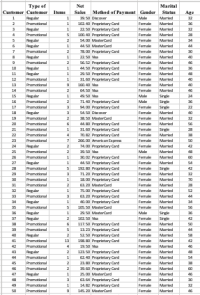
1. Percent frequency distributions for each of the key variables: number of items purchased, net sales, method of payment, gender, marital status, and age. [Show the distribution’s graph as well]
2. A sorted bar chart showing the number of customer purchases attributable to the method ofpayment.
3. A crosstabulation of type of customer (regular or promotional) versus net sales. Comment on any similarities of differences observed.
4.A scatter chart to explore the relationship between net sales and customer age.
5.A chart to examine whether the relationship between net sales and age depends on the marital status of the customer.
6.A side-by-side bar chart to examine the method of payment by customer type (regular or promotional). Comment on any differences you observe between the methods of payments used by the different types of customers.


Trending nowThis is a popular solution!
Step by stepSolved in 3 steps with 7 images

- This data was collected from the members of our class. I have tried to remove anything that would identify an individual. 1. What is the scale of each variable? 2. Construct a frequency table and chart showing the distribution across gender in this class. 3. Construct a cross tabulation with Gender in one direction and Height in the other direction. Group the height category into 5 groups. 4. Is there a difference in the age distribution across gender? 5. Give a summary of our class based on this data about our class. Gender Height Year Born Male 76 1994 Male 72 1983 Female 65 1997 Male 68 1966 Female 67 1997 Male 70 1996 Male 71 1996 Male 73 1996 Male 72 1995 Male 71 1998 Male 73 1993 Female 66 1980 Female 62 1998 Male 76 1984 Female 70 1985 Female 62 1992 Female 62 1992 Male 73 1996 Female 68 1987 Male 60 1971 Female 60 1971 Male 60 1971 Male 74 1970 Male 77 1998 Male 77 1998 Male 68 1990 Female 64 1996 Male 80 1997 Male…arrow_forwardThe Big Mac index is a way of measuring Purchasing Power Parity (PPP) between different countries. By diverting the average national Big Mac prices to U.S. dollars, the same goods can be informally compared. The Big Mac can also be a good indicator for the individual purchasing power of an economy since he exists worldwide in standard size, composition and quality. Price # of Countries Rel. f. Cum. f 1.50-1.99 2 2.00-2.49 4 2.50-2.99 7 3.00-3.49 9 3.50-3.99 7 4.00-4.49 8 4.50-4.99 9 5.00-5.49 7 5.50-5.99 1 6.00-6.49 2 6.50-6.99 1arrow_forwardSelect the correct answer and write the appropriate letter in the space provided _____ 1. A grouping of data into classes giving the number of observations in each class is called a(an) a bar chart. b. frequency distribution. c. pie chart. d. cumulative frequency distribution. ______ 2. The distance between consecutive lower class limits is called the a. class interval. b. frequency distribution. c. class midpoint. d. class frequency. ______ 3. The class midpoint is a. equal to the number of observations. b. found by adding the lower class limits of two consecutive classes and dividing by 2. c. equal to the class interval. d. all of the above. ______ 4. The number of observations in a particular class is called the a. class interval. b. class frequency. c. frequency distribution. d. none of the above. ______ 5. A bar chart is used most often when a. you want to show frequencies as compared to total observations. b. you want to show…arrow_forward
- Determine whether the following examples are discrete or continuous data sets. Write "DISCRETE" for discrete and "CONTINUOUS" for continuous. (without quotations - use for instance copy and paste to avoid typos) (a) The number of voters who vote Democratic answer. (b) The temperature in any given location. answer. (C) The distance traveled by a city bus each day. answer. (d) The length of time needed for a student to complete a homework assignment. answerarrow_forwardThe attached plots were constructed using a sample of 272 observations. Each observation gives the elapsed time (in minutes) of an eruption of Old Faithful geyser in Yellowstone national park. a. Which graph is more appropriate for this data set? Explain your answer. b. Use the plots to describe the shape of the distribution of this data set. c. Are there are any potential outliers in this sample? Explainarrow_forwardInterpret the side-by-side (comparative) box-and-whisker plot using the five-number summary. Compare and discuss the typical annual starting salaries for each major. What conclusions can be drawn? Describe each distribution for accounting and marketing majors' annual starting salary.arrow_forward
- a. Make the case with graphs and numbers that women are a growing presence in the U.S. military. b. Make the case with graphs and numbers that women are a declining presence in the U.S. military. c. Write a paragraph that gives a balanced picture of the changing presence of women in the military using appropriate statistics to make your points. What additional data would be helpful?arrow_forward2.7 - a. Write a few short sentences that compare the center and the spread for each dot plot. b. Based on this sample, cereals from which manufacturer tend to have no variation in calories?arrow_forward
 MATLAB: An Introduction with ApplicationsStatisticsISBN:9781119256830Author:Amos GilatPublisher:John Wiley & Sons Inc
MATLAB: An Introduction with ApplicationsStatisticsISBN:9781119256830Author:Amos GilatPublisher:John Wiley & Sons Inc Probability and Statistics for Engineering and th...StatisticsISBN:9781305251809Author:Jay L. DevorePublisher:Cengage Learning
Probability and Statistics for Engineering and th...StatisticsISBN:9781305251809Author:Jay L. DevorePublisher:Cengage Learning Statistics for The Behavioral Sciences (MindTap C...StatisticsISBN:9781305504912Author:Frederick J Gravetter, Larry B. WallnauPublisher:Cengage Learning
Statistics for The Behavioral Sciences (MindTap C...StatisticsISBN:9781305504912Author:Frederick J Gravetter, Larry B. WallnauPublisher:Cengage Learning Elementary Statistics: Picturing the World (7th E...StatisticsISBN:9780134683416Author:Ron Larson, Betsy FarberPublisher:PEARSON
Elementary Statistics: Picturing the World (7th E...StatisticsISBN:9780134683416Author:Ron Larson, Betsy FarberPublisher:PEARSON The Basic Practice of StatisticsStatisticsISBN:9781319042578Author:David S. Moore, William I. Notz, Michael A. FlignerPublisher:W. H. Freeman
The Basic Practice of StatisticsStatisticsISBN:9781319042578Author:David S. Moore, William I. Notz, Michael A. FlignerPublisher:W. H. Freeman Introduction to the Practice of StatisticsStatisticsISBN:9781319013387Author:David S. Moore, George P. McCabe, Bruce A. CraigPublisher:W. H. Freeman
Introduction to the Practice of StatisticsStatisticsISBN:9781319013387Author:David S. Moore, George P. McCabe, Bruce A. CraigPublisher:W. H. Freeman





